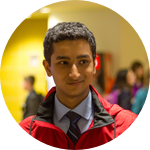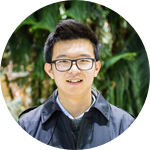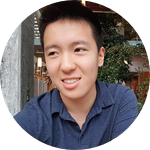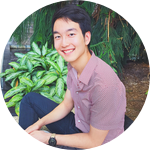About This Project
Cancerous tumors are surrounded by what is termed a "tumor microenvironment" that distinguishes them from normal tissue due to its lack of oxygen and highly acidic state. We will use these defining features of the tumor environment as inputs for an bacterial genetic circuit with growth and release of cytotoxic agent only following the detection of these tumor microenviroment signals. Upon clearance of the tumor, the bacteria can be easily be cleared.
Ask the Scientists
Join The DiscussionWhat is the context of this research?
Current chemotherapeutic strategies are non-specific, in that, they attempt to "starve" the cancerous tissue but in doing so, begin to harm healthy tissue. Tumors create a specific microenvironment which further promotes resistance against treatment. The lack of specificity in these treatments leads to the onset of side effects throughout the treatment regiment.
Bacterial quorum sensing controls colony growth through chemical signalling molecules in response to environmental conditions. The Pseudomonas AeruginosaQuorum Sensing molecule, AHL-C12, acts as both a cytotoxic and bacterial signalling molecule. Our engineerined genetic circuit uses characteristics of the tumor microenvironment as an input signal and allows bacteria to regulate itself.
What is the significance of this project?
The successful implementation of the genetic circuit in E. coli provides a proof-of-concept for the use of an autoinducer molecule, such as C12, as both a cytotoxic and regulatory signalling molecule. The novelty of our project lies in the selective expression of E. coli in the tumor microenvironment. By seeking to create a bacterial platform that can both detect and treat disease and a lab-on-a-chip component to assess our results, the scope of the proposed project is fully in vitro. The proposal nonetheless has important implications for disease treatment, be it the potential of C12 as a cancer treatment or the use of our microfluidic chip for cell sorting fine-tuned for quorum sensing purposes in biomedical research.
What are the goals of the project?
The goal of this project is to create a strain of bacteria that can (1) sense the tumor microenvironment (i.e. low pH and low oxygen), (2) produce C12 which will induce cancer cell death, and (3) create a feedback system such that when the tumor microenvironment is not present (i.e. in other regions or after the tumor is removed), the bacteria self-destruct.
To do so, our goal is to engineer a genetic circuit with an AND gate, requiring both a low pH Input (through gadAp) and low oxygen (through Pfdhf) to activate the transcription of AHL synthase which produces C12. The C12 will promote cancer apoptosis, or bind to a repressor, suppressing the bacterial "death" signal. The plasmids will be optimized in E. coli.
Budget
Science is expensive. Your generous donations will allow us to purchase the necessary equipment and supplies to conduct our experiments.
Primers, restriction enzymes, DNA synthesizing enzymes allow us to do the necessary cloning to construct plasmids.
DNA sequencing allows us to confirm that our engineered circuits are constructed sequentially, in the correct orientation.
Mini-prep and Gel extraction kits allow us to isolate and purify DNA and implement them into new bacterial strains.
Endorsed by
 Project Timeline
Project Timeline
We will present our work at the iGEM jamboree in Boston, MA starting on Nov. 9, 2013.
May 10, 2017
Project Launch
Aug 20, 2017
Implement P. Aeruginosa quorum sensing into E. coli
Aug 21, 2017
Project Launched
Aug 26, 2017
Create microfludic chip to sort cells to create specialized quorum sensing assay
Aug 31, 2017
Create AND gate to combine pH and Hypoxia with C12 signalling
Meet the Team
Affiliates
Affiliates
Affiliates
Affiliates
Affiliates
Affiliates
Affiliates
McMaster iGEM 2
The International Genetically Engineered Machine (iGEM) Foundation is dedicated to education and competition, advancement of synthetic biology, and the development of open community and collaboration. In 2012, iGEM spun out of MIT and became an independent nonprofit organization located in Cambridge, Massachusetts, USA. iGEM fosters scientific research and education by establishing and operating the Registry of Standard Biological Parts, a community collection of biological components. The organization promotes the advancement of science and education by developing an open community of students and practitioners in schools, laboratories, research institutes, and industry.
Adree Khondker
Hi! I am a year III student in Biochemistry and Biomedical Sciences (B.HSc). On McMaster iGEM Team 2, I use molecular dynamics simulations and SAXS to predict protein-protein interactions, in order to predict mutations that will increase protein efficacy and signalling in vitro. When not doing iGEM, I work in soft condensed-matter and membrane biophysics.
Peter Zeng
I am a third-year student in the B.HSc Biomedical Sciences Specialization. I am leading the development of the genetic circuit to provide an self-regulating, in situ therapeutic option to prostate cancer. Outside of iGEM, I am working on a research project exploring the intersection between several neurodegenerative genes (ex. Setx, Ighmbp2) and the immune response using genetic engineering methods such as CRISPR.
Brian Lee
Hello! I am a year III student in Computer Engineering (B.Eng). On the McMaster iGEM Team 2, I oversee the design and simulation of a dielectrophoretic chip for bioparticle separation. For me, iGEM is a great opportunity to learn about exciting research outside of one's typical domain and develop teamwork and research skills that are applicable in any setting. Outside of iGEM, I am an augmented and virtual reality software developer and am currently exploring machine learning.
Beny Giller
I am a year III student in Computer Science at Mcmaster University, I am the one responsible for making the website on the IGEM site for out team. For me IGEM is a great way to do more professional work and expand my programming capabilities. Outside of IGEM I mostly work as a database admin and do other programming projects on the side.
Vienna Mazzoli
I am a second year student specializing in biomedical sciences at McMaster. On iGEM, I am involved in the engineering and synthetic biology sides of the project. I have had the opportunity to learn from my teammates over the year, and am thrilled to be able to put this newly gained knowledge into practice while working on our project. Outside of iGEM, I am currently researching the mechanisms by which ER stress contributes to the progression of diabetic retinopathy.
Edward Li
Hello! I am a second year student studying health sciences here at McMaster University. My fascination is in stem cells and their ability to be molded into anything of the heart's desire. What particularly captivates me is that this unique potency can be harnessed to replace, regenerate, and repair for people with currently incurable diseases. iGEM, and the premise behind genetic engineering, speaks to me for the exact same reasons. Through iGEM, we could utilize the very same rules that allowed human cells to self-regulate to build circuits of complex functions and inputs, thus making synthetic biology an exciting field.
Owen Luo
As a member of McMaster iGEMII, I am responsible for modelling the mathematical relationships between inputs and outputs in order to fathom and predict the behaviour of our genetic circuit in a diverse spectrum of potential conditions. Outside of my iGEM work, I work on exploring the effect of the adaptive immune system on neurogenesis in the central nervous system through the use of knockout mouse models.
Tim Wu
I am a third year student studying biochemistry with a biomedical research specialization. The versatility of bacterial systems is what first attracted me to the iGEM competition, as they can be designed to tackle unique challenges. On the team, I am responsible for designing and implementing the quorum sensing component of our genetic circuit. Outside of iGEM, I am identifying molecular chaperones that can prevent uromodulin-albumin aggregates in chronic kidney disease.
Aman Patel
I am a third year student studying biochemistry with a specialization in biomedical research. The idea of synthetic biology is what attracted me to iGEM. On the team, I help create the genetic circuits that will be used for quorum sensing. Outside of iGEM, I examine the fermentation patterns of the microbes present in the human gut with the overall goal of determining how to human microbiome is established in infants.
Lab Notes
Nothing posted yet.
Project Backers
- 2Backers
- 1%Funded
- $9Total Donations
- $4.50Average Donation











